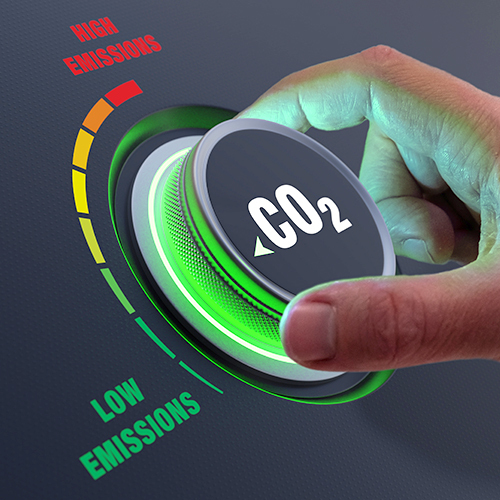Fleet decarbonisation is a critical step towards achieving Net Zero emissions goals and a more sustainable future. The transport and logistics sectors are estimated to be responsible for generating 33% of global carbon emissions, with road vehicles being a significant contributor within that. Decarbonisation is a process that involves reducing carbon emissions produced by fleet vehicles used for business operations.
In this guide we will explain the meaning of fleet decarbonisation and highlight strategies for reducing fleet greenhouse gas emissions – from fleet electrification to leveraging renewable energy. We’ll also explore the benefits and challenges of doing so.
Whether you’re a fleet manager, sustainability officer, or business owner, on the journey to making your operations greener, this guide is for you.
Table of contents:
- What is fleet decarbonisation?
- Key drivers of carbon emissions
- Selecting the right approach for your fleet
- Benefits of decarbonising your fleet
- Emissions tracking and reporting
- Telematics and eco-driving training
- Route optimisation
- Renewable energy and carbon offsetting
What is fleet decarbonisation?
Fleet decarbonisation involves reducing the carbon emissions (CO2e) produced by a company’s fleet of vehicles. This process is essential for minimising environmental impact, improving fleet sustainability and combating climate change. It requires adopting practices and technologies that lower emissions across vehicle operations.
Decarbonising your fleet operations goes beyond just switching to electric vehicles (EVs) though. It includes incorporating renewable energy, optimising routes, and training drivers to employ efficient driving techniques. By understanding and leveraging these tactics, businesses can develop a holistic approach to reduce fleet emissions and improve sustainability. Embracing these strategies not only helps the environment, but also enhances operational efficiency and brand reputation.
Key drivers of carbon emissions
As noted above, road-based logistics is a significant source of carbon emissions, contributing to air pollution and climate change.
Key contributors to emissions include:
- Fuel combustion from ICE and hybrid vehicles
- Inefficient driving practices
- Engine idling
- Inefficient route planning
- Poor vehicle maintenance
By addressing these issues, fleet operators can significantly diminish their carbon footprint. This is vital for achieving broader sustainability goals and ensuring regulatory compliance.
Selecting the right approach for your fleet
The best approach for reducing carbon emissions depends on the make up of your fleet. For fleets mainly composed of internal combustion engine (ICE) cars, for example, switching to EVs would likely deliver a significant impact .
Whereas for HGV fleets, where realistic electric alternatives and charging infrastructure isn’t available, focusing on route optimisation and fuel-efficient driving practices would likely yield the biggest reduction in emissions.
Of course, often though it is not as clear cut as the examples above, with the majority of fleets including a mix of EVs, ICE cars and vans, and HGVs. In reality, a phased adoption of EVs, whilst utilising AI fleet optimisation to reduce emissions from existing ICE vehicles might be the right approach for many fleets.
Regulatory drivers for decarbonisation
Governments worldwide are implementing stricter environmental regulations aimed at curbing carbon emissions from the transportation sector, with financial penalties for non-compliance. These provide a strong incentive for forging ahead with fleet decarbonisation efforts.
For example, the Ultra Low Emission Zone (ULEZ) in London and Clean Air Zones across other UK cities enforce daily charges for vehicles emitting emissions above a certain level, with fines of up to £180 for non-compliance.
What’s more, the UK government plans to ban the sale of all new petrol and diesel cars and vans from 2035, meaning owners of car and van fleets will soon need to switch to EVs in order to comply.
Many governments are also offering incentives to drive the adoption of low-emission vehicles and technologies. In the UK for example, the workplace charging scheme offers grants to cover up to 75% of the costs for businesses to purchase and install EV charging points.
Benefits of decarbonising your fleet
Decarbonising your fleet offers numerous advantages beyond the core environmental benefits. It can lead to significant cost savings over time, with reduced fuel consumption lowering operational expenses and enhancing profitability.
Improved brand image is another key advantage. Consumers increasingly prefer companies committed to sustainability and behaving in environmentally responsible ways. By reducing emissions, businesses can strengthen their market position and attract environmentally conscious customers.
Here are some of the main benefits:
- Increased operational efficiency
- Lower fuel and maintenance costs
- Enhanced corporate reputation and brand value
- Compliance with environmental regulations
- Potential access to government incentives and grants
Shifting to electric vehicles (EVs) is a pivotal strategy for fleet decarbonisation. EVs produce zero greenhouse gas emissions, drastically reducing your fleet’s carbon footprint. Investment in charging infrastructure is essential for a smooth transition.
Exploring alternative fuels like biodiesel, natural gas, and hydrogen offers further decarbonisation options. These fuels can significantly cut emissions compared to traditional diesel or petrol. Each option requires careful consideration of compatibility and cost-effectiveness for your specific fleet needs.
Emissions tracking and reporting
Accurately tracking emissions is essential for effective fleet decarbonisation initiatives. Reliable data allows for informed decision-making, goal setting and progress monitoring.
Reporting emissions not only helps comply with regulations but also improves transparency. It builds trust with stakeholders and enhances your brand’s reputation. Regular reporting can highlight areas for improvement in your decarbonisation strategy.
Vehicle retrofitting and maintenance
Retrofitting vehicles offers a practical approach to reduce fleet emissions without purchasing new fleet. This approach can be particularly useful (and economical) for HGVs and older heavy duty vehicles where the replacement cost is high.
By installing emission-reduction technologies, fleets can significantly cut their carbon footprint.
The Clean Vehicle Retrofit Accreditation Scheme (CVRAS) certifies retrofit technologies that meet UK government standards and provides technology neutral advice.
Regular maintenance plays a vital role in maintaining fleet efficiency, as well-maintained vehicles burn less fuel and produce fewer emissions. Ensuring daily walkaround checks are completed can prevent issues that increase carbon output, supporting overall decarbonisation efforts .
Apps, such as Trakm8’s vehicle checks app can support drivers in ensuring vehicle checks are completed to the right standard and at the correct intervals. The Government also provides guidance on how to complete daily walk around checks for vans and other vehicles.
Telematics and eco-driving training
Telematics systems provide valuable data for monitoring and improving fleet performance. By analysing driving behaviour patterns, these systems help to optimise fuel usage and reduce emissions. They also identify areas where drivers can improve.
On-board behaviour monitoring and feedback devices, such as the Trakm8 ACC750, can also be effective measures. The ACC750 notifies drivers and provides coaching in real-time when inefficient driving events which drive up fuel usage occur, for example harsh acceleration.
Eco-driving training complements telematics by teaching drivers fuel-efficient techniques. These programs focus on smooth acceleration, maintaining steady speeds, and other eco-friendly practices. Together, telematics and driver training significantly contribute to reducing fleet emissions.
League tables and incentive schemes which reward the most sustainable drivers can be effective ways to encourage drivers to consistently implement eco-friendly driving practices. Trakm8’s Insight platform enables this by automatically collating and visualising driver behaviour data to produce league tables – allowing recognition and prizes to be given to those driving most economically.
Route optimisation and supply chain management
Route optimisation is a key strategy for cutting fleet emissions. By planning efficient routes, you minimise unnecessary mileage and fuel consumption. This approach reduces the carbon footprint and saves on fuel costs .
More efficient routes also have a positive knock on effect on driver behaviour. Better routes reduce driver stress and reduce the likelihood of less sustainable driving behaviours occurring (such as speeding or harsh cornering), having a positive impact on emissions.
Supply chain management also plays a vital role in fleet decarbonisation. Coordinating with suppliers to schedule deliveries efficiently enhances operational efficiency. This collaboration helps to further reduce emissions throughout the supply chain.
Renewable energy and carbon offsetting
Integrating renewable energy into fleet operations is an effective way to reduce emissions. Many companies use solar panels to charge electric vehicles or even vehicle mounted solar panels for ICE vehicles to provide batteries with a constant trickle charge and power ancillary devices. This approach ensures that the energy used is clean and sustainable .
Carbon offsetting offers another path to decarbonisation, involving compensating for emissions by investing in environmental projects. These projects might include reforestation or renewable energy initiatives. While not a sole solution, carbon offsetting is an element of a broader decarbonisation programme and complements efforts to minimise fleet emissions.
Government incentives and lifecycle analysis
Government incentives play a crucial role in fleet decarbonisation efforts. These incentives can include tax breaks, grants, and subsidies. They aim to reduce the initial costs of adopting cleaner technologies. Such incentives encourage companies to invest in electric and alternative fuel vehicles.
Lifecycle analysis is essential for evaluating the full impact of fleet operations. It assesses environmental effects from production to disposal. This analysis helps identify areas where emission reductions can be made. By understanding the complete lifecycle of their fleet, companies can make informed decisions. Optimised strategies based on lifecycle analysis lead to sustainable fleet management.
Overcoming challenges and setting goals
Fleet decarbonisation presents various challenges that must be addressed, including high up-front costs, technical limitations, and resistance to change. Companies need to develop strategies to overcome these obstacles, leveraging government incentives and technology to ease the transition.
Setting clear and measurable decarbonisation goals is key to success. Goals help in tracking progress and maintaining focus, and should be aligned with broader sustainability objectives. By setting realistic goals and continuously monitoring them, businesses can progressively reduce emissions. Effective goal-setting fosters accountability and ensures sustained commitment to fleet decarbonisation.
The future of fleet decarbonisation
The future of fleet decarbonisation is bright, with technological advances driving seismic change.
Continued innovation, particularly through AI-enhanced monitoring and optimisation solutions, is already enabling fleet operators to take strides in reducing carbon emissions. For example, Trakm8’s AI optimisation solution enabled a major UK supermarket to reduce its CO2 emissions by 4,000 tonnes, and another fleet operator to drive down emissions by over 57%. This innovation is set to continue.
As regulations tighten, more businesses will adopt sustainable practices. Integration of electric vehicles and alternative fuels will become standard.
Emerging technologies and collaboration will lead to cleaner, more efficient fleets – benefiting both the environment and businesses’ bottom lines.


